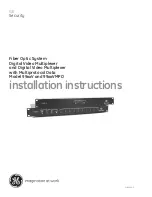
210-0000025 rev04
Frame Type
Frame type is the T1 data encapsulation method. A frame consists of 193 bits (8-bit samples of
each of the 24 T1 channels plus a synchronization bit) transmitted at a rate of 8,000 frames per
second (1,544 kbps) across the T1 line.
Super Frame
Super Frame (SF) format assembles data into 12-frame transmission clusters.
Extended Super Frame (Default)
Extended Super Frame (ESF) format, used in Wide Area Networks (WANs), assembles data
into 24-frame transmission clusters and integrates the following:
!
Facilities Data Link (FDL) - communication support through in-service monitoring
and diagnostics
!
Cyclic Redundancy Check (CRC) - detects line errors and scrutinizes data integrity
Line Code
Line code is the T1 mode of transmission. The following line code options fall within the
International Telecommunication Union - Telecommunication Standardization Sector (ITU-T)
G.703 Standards for Transmission Facilities.
Bipolar with 8 Zero Substitution (Default)
Bipolar with 8 Zero Substitution (B8ZS) is used to accomodate the minimum ones density
requirement in the North American public network. B8ZS line coding helps prevent loss
of synchronization between the TAM1500-12 and remote T1 modems by using bipolar
violations to guarantee there will always be pulses in the line.
Alternate Mark Inversion
The Alternate Mark Inversion (AMI) mode of transmission simply alternates positive and
negative pulses. It is typical, with AMI, for a link to encounter long strings of zeros which
can potentially cause loss of synchronization between remote units. Net to Net
Technologies' products however, meet the North American minimum ones density
requirement internally such that, even with AMI, loss of synchronization is prevented
between the TAM1500-12 and remote T1 modems as it is with B8ZS line coding.
Tx (Transmit) Buildout
Shorter distances between the TAM1500-12 and remote modems require increasing line
attenuation in order to prevent the T1 signal from becoming too strong for the repeaters,
switches and other T1 transmission equiment that may be encountered along the line. Increased
line attenuation translates into decreased transmit amplitude of the T1 signal.
NOTE
Although all 24 channels continually run at 1,536 kbps, the Timeslot configuration for each port determines
how many of the channels will be receiving data for that port. Ports configured to operate as fractional T1
lines require contiguous timeslots, as indicated in the table above.


























